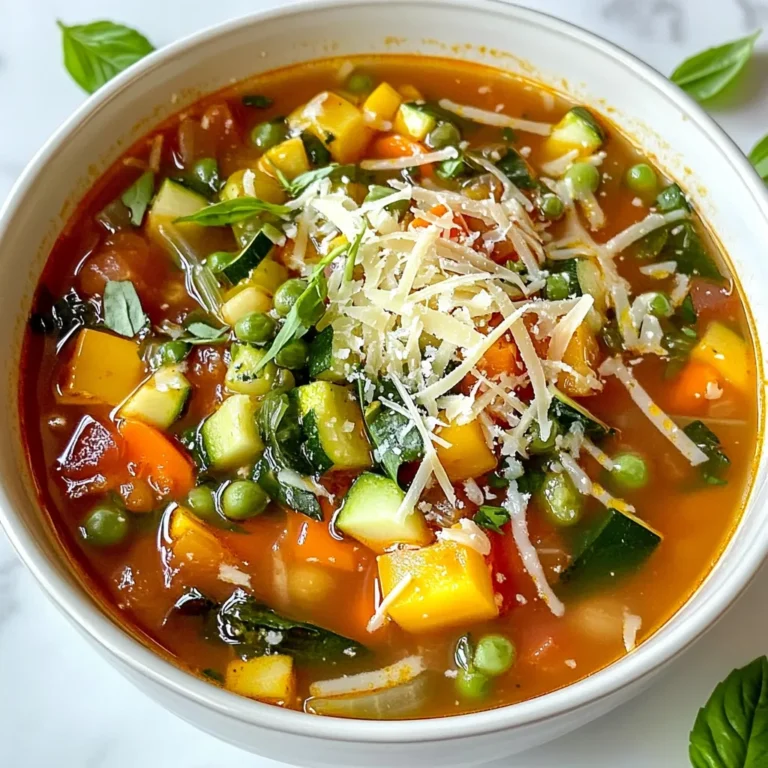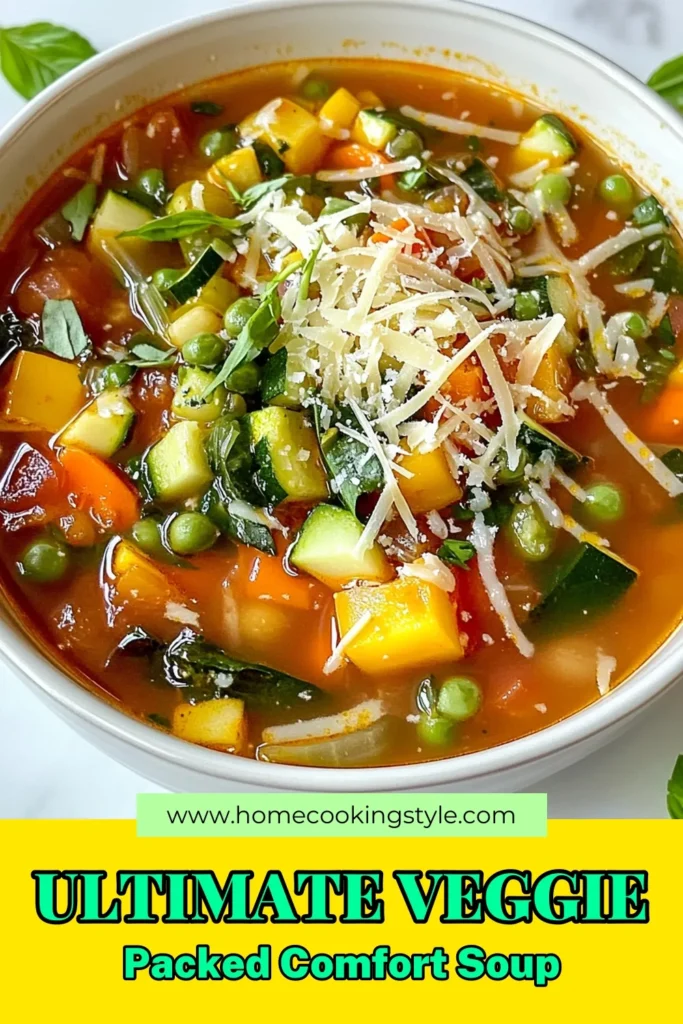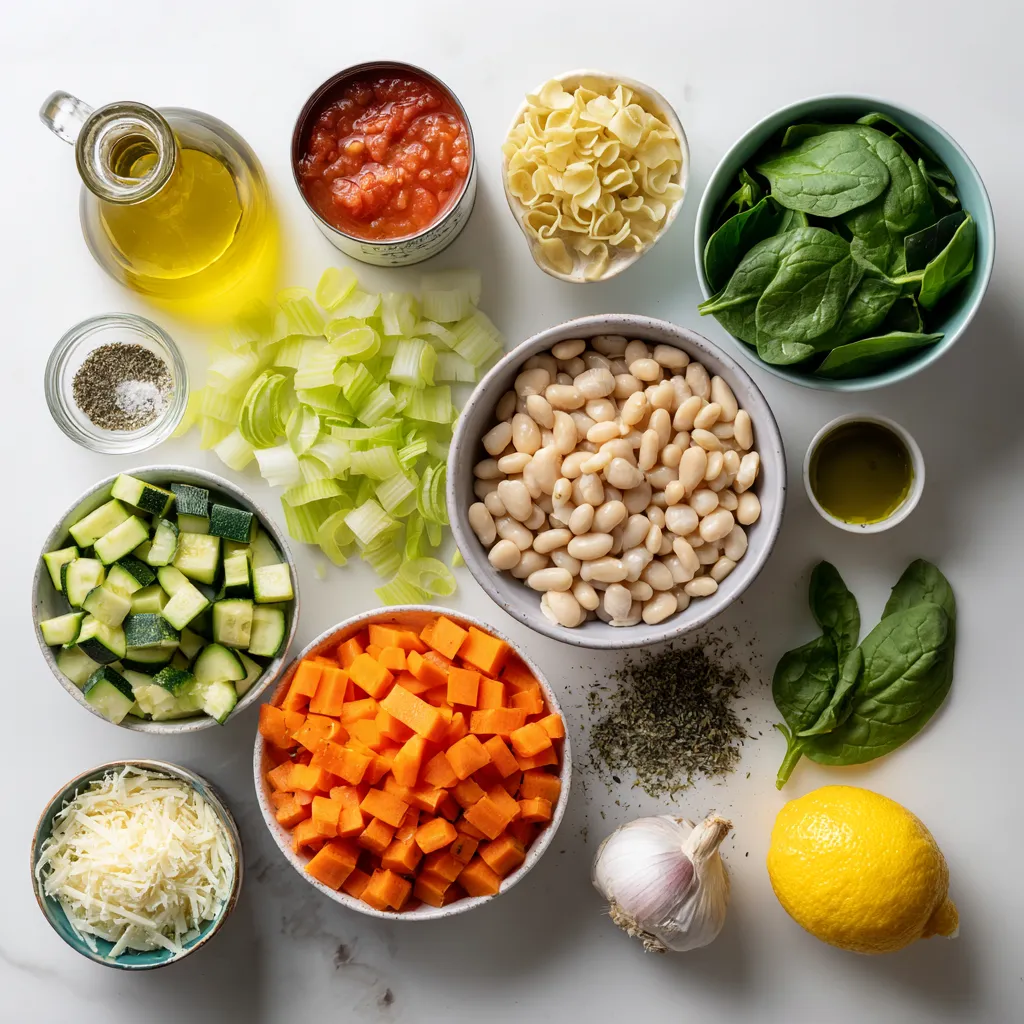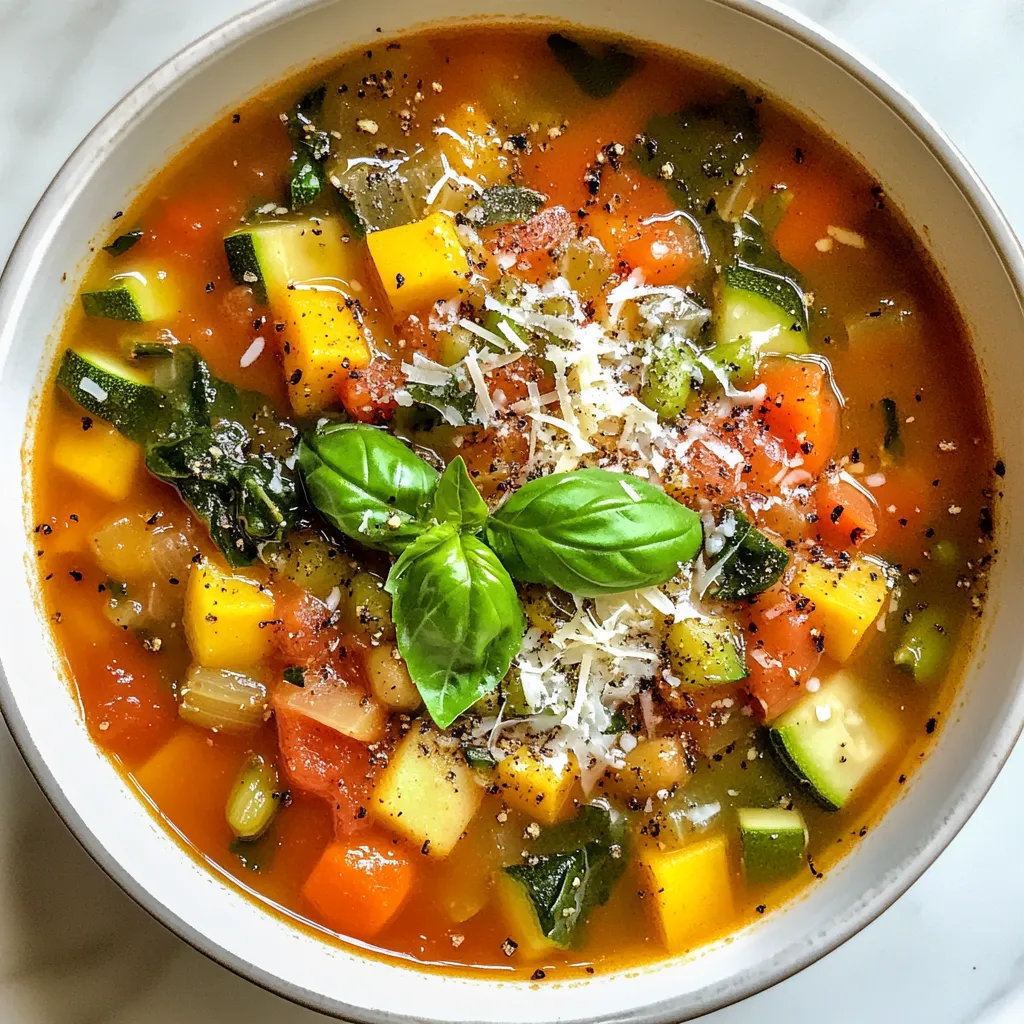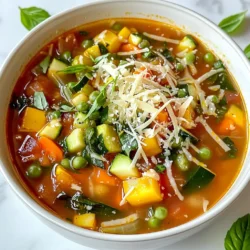WANT TO SAVE THIS RECIPE?
Looking for a warm, cozy dish that’s packed with goodness? This Veggie Packed Minestrone Soup is just what you need! It’s hearty and full of fresh flavors, making it the perfect meal for any day. In this article, I will guide you through the ingredients, cooking steps, and handy tips to make a delicious soup that is fun to customize. Get ready to bring comfort and health to your table!
Why I Love This Recipe
- Healthy and Nutritious: This minestrone soup is packed with a variety of vegetables, making it a great source of vitamins and minerals.
- Comforting and Hearty: The combination of beans and pasta creates a satisfying and filling meal that warms you from the inside out.
- Customizable: You can easily swap out vegetables or add your favorite protein to make it your own.
- Quick and Easy: This recipe comes together in under an hour, perfect for busy weeknight dinners.
Ingredients
Complete list of ingredients
To make veggie packed minestrone soup, gather these simple ingredients:
– 1 tablespoon olive oil
– 1 medium onion, diced
– 2 cloves garlic, minced
– 2 carrots, diced
– 2 celery stalks, diced
– 1 zucchini, diced
– 1 cup green beans, trimmed and cut into pieces
– 1 can (15 oz) cannellini beans, drained and rinsed
– 1 can (14.5 oz) diced tomatoes (with juice)
– 6 cups vegetable broth
– 1 teaspoon dried oregano
– 1 teaspoon dried basil
– Salt and pepper to taste
– 1 cup small pasta (like ditalini or elbow)
– 2 cups fresh spinach or kale
– 1 tablespoon lemon juice
– Grated Parmesan cheese (for serving, optional)
Fresh vs. canned options
Using fresh ingredients gives the best taste. Fresh vegetables add crunch and flavor. If you’re short on time, canned options work well too. Canned beans and tomatoes save prep time. Always rinse canned goods to cut down on salt.
Substitutions and allergy-friendly alternatives
You can swap ingredients based on your needs. If you have a bean allergy, use more veggies instead. Try lentils or chickpeas for protein. If you don’t eat gluten, choose gluten-free pasta. For a dairy-free option, skip the cheese. Always adjust to fit your taste and diet.

Step-by-Step Instructions
Detailed cooking process
Start by heating the olive oil in a large pot over medium heat. Add the diced onion and sauté until it turns soft and clear, about 3-4 minutes. Next, stir in the minced garlic, carrots, and celery. Cook these for about 5 minutes, stirring often. You want the veggies to soften nicely.
Then, add the zucchini, green beans, and cannellini beans to the pot. Mix everything well. Pour in the diced tomatoes with their juice and the vegetable broth. Season the soup with oregano, basil, salt, and pepper. Bring the mixture to a boil. Once boiling, lower the heat and let it simmer for about 15 minutes. This step helps all the flavors blend together.
After that, add the small pasta to the pot. Cook it according to the package instructions until it is al dente, which usually takes about 7-10 minutes. In the last 2 minutes of cooking, stir in the fresh spinach or kale. This will make it bright and healthy. Finally, remove the pot from the heat and stir in lemon juice for a fresh taste.
Tips for sautéing vegetables
When you sauté vegetables, make sure to keep the heat at medium. This helps them cook evenly without burning. Cut the veggies into similar sizes so they cook at the same time. Stir them often during cooking to avoid sticking. If you want more flavor, add a pinch of salt right when you start cooking. This helps draw out moisture and adds more taste.
Cooking pasta in the soup
Cooking pasta in the soup is easy and saves time. Just add it to the pot when the soup is almost done. Follow the package instructions for cooking time. This way, the pasta soaks up the soup’s flavor. For best results, do not overcook the pasta. It should be firm, or al dente. If you have leftovers, consider cooking the pasta separately next time. This prevents it from getting too soft when you reheat the soup.
Tips & Tricks
How to enhance flavor and nutrition
To boost the flavor, use fresh herbs. Fresh basil and oregano add great taste. You can also try adding a splash of balsamic vinegar for depth. For nutrition, include leafy greens like spinach or kale. They add vitamins and minerals. You can also add some lemon juice for a zesty kick.
Best practices for using leftover vegetables
Don’t let leftover veggies go to waste. Chop them up and toss them into your soup. Carrots, bell peppers, or even broccoli work well. Just make sure they are cut small so they cook fast. This way, you add flavor and nutrition. You can also mix in any cooked grains you have on hand, like quinoa or rice.
Adjusting thickness and consistency
If your soup is too thick, add more vegetable broth or water. Stir it in slowly until you reach your desired thickness. If it is too thin, let it simmer longer to reduce. You can also mash some beans against the pot’s side for a thicker texture. This will give your soup a hearty feel without extra ingredients.
Pro Tips
- Use Fresh Veggies: Fresh vegetables enhance the flavor and nutritional value of the soup. Opt for seasonal produce whenever possible.
- Customize Your Pasta: Feel free to substitute the small pasta with whole grain or gluten-free options for a healthier twist.
- Make It Ahead: This minestrone soup tastes even better the next day! Make a big batch and store leftovers in the fridge for quick meals.
- Adjust Your Seasoning: Always taste your soup before serving. Feel free to adjust the seasoning with more herbs or a splash of vinegar for extra flavor.

Variations
Gluten-free minestrone options
You can make minestrone soup gluten-free easily. Just swap the small pasta for gluten-free pasta. Many brands offer great options that taste good. You can also use rice or quinoa instead of pasta. Both add a nice texture and keep the soup hearty.
Adding protein (e.g., chicken, tofu)
If you want to add protein, you have great choices. For meat lovers, diced chicken is tasty. Cook it in the pot before adding veggies to let it brown. If you prefer plant-based protein, try adding cubed tofu. Add it with the beans for a nice, firm texture. Both options make the soup more filling.
Seasonal vegetable variations
Seasonal veggies make this soup even better. In the spring, add peas or asparagus for a fresh taste. Summer brings sweet corn and bell peppers, perfect for a bright flavor. In the fall or winter, use root vegetables like squash or parsnips. Mixing and matching seasonal veggies keeps the soup fun and exciting.
Storage Info
Refrigeration guidelines
After cooking your veggie packed minestrone soup, let it cool. Store it in an airtight container. It will stay fresh in the fridge for about 3 to 5 days. Always check for any off smells before eating. If you see any signs of spoilage, toss it out.
Freezing leftover soup
You can freeze the soup if you want to keep it longer. Use a freezer-safe container or a heavy-duty freezer bag. Make sure to leave some space for the soup to expand when it freezes. It can last for up to 3 months in the freezer. To thaw, place it in the fridge overnight or use the microwave for a quick defrost.
Reheating instructions
When you’re ready to eat, reheat your soup on the stove or in the microwave. If using the stove, warm it over medium heat until hot. Stir occasionally to prevent sticking. If you’re using a microwave, heat it in 1-minute intervals, stirring in between. Add a splash of vegetable broth or water if it seems too thick. Enjoy your warm and hearty soup!
FAQs
How long does minestrone soup last in the fridge?
Minestrone soup lasts about 3 to 5 days in the fridge. Store it in an airtight container. This keeps it fresh and safe to eat. If you notice any off smells or colors, it’s best to toss it out.
Can I make this soup ahead of time?
Yes, you can make this soup ahead of time. It tastes even better after sitting for a day. The flavors blend well, making it rich and tasty. Just let it cool before putting it in the fridge. Reheat it when you’re ready to enjoy.
Is minestrone soup vegan-friendly?
Yes, this minestrone soup is vegan-friendly. It uses vegetable broth and no animal products. You can enjoy this dish while sticking to a plant-based diet. Just skip the cheese if you want it completely vegan!
You learned about making tasty minestrone soup with fresh, canned, and substitute options. The step-by-step guide showed how to cook perfectly. Tips helped enhance flavors and use leftovers smartly. We discussed gluten-free and protein-packed variations, plus easy storage and reheating.
In closing, this soup is simple to make and fun to share. Enjoy creating your own version! Each bowl brings warmth and joy. Try new ingredients and make it your
Veggie Packed Minestrone Soup
A hearty and nutritious soup filled with vegetables and pasta, perfect for a comforting meal.
Prep Time 15 minutes mins
Cook Time 30 minutes mins
Total Time 45 minutes mins
- 1 tablespoon olive oil
- 1 medium onion, diced
- 2 cloves garlic, minced
- 2 number carrots, diced
- 2 number celery stalks, diced
- 1 number zucchini, diced
- 1 cup green beans, trimmed and cut into pieces
- 1 can cannellini beans, drained and rinsed (15 oz)
- 1 can diced tomatoes (with juice) (14.5 oz)
- 6 cups vegetable broth
- 1 teaspoon dried oregano
- 1 teaspoon dried basil
- to taste salt and pepper
- 1 cup small pasta (like ditalini or elbow)
- 2 cups fresh spinach or kale
- 1 tablespoon lemon juice
- optional Grated Parmesan cheese (for serving)
In a large pot, heat the olive oil over medium heat. Add the diced onion and sauté until translucent, about 3-4 minutes.
Stir in the minced garlic, carrots, and celery. Cook for another 5 minutes, stirring occasionally, until the vegetables begin to soften.
Add the zucchini, green beans, and cannellini beans to the pot, stirring to combine.
Pour in the diced tomatoes along with their juice and the vegetable broth.
Season the mixture with oregano, basil, salt, and pepper. Bring the soup to a boil, then reduce the heat to a simmer.
Allow the soup to simmer for about 15 minutes, allowing the flavors to meld together.
Add the pasta to the pot and cook according to the package instructions until al dente (usually about 7-10 minutes).
In the last 2 minutes of cooking, stir in the fresh spinach or kale until wilted.
Remove from heat and stir in the lemon juice for a bright finish.
Taste and adjust seasoning if necessary before serving.
Ladle the minestrone soup into bowls and sprinkle with grated Parmesan cheese if desired. Garnish with a sprig of fresh basil or a wedge of lemon on the side for extra brightness.
Keyword minestrone, soup, veggie
WANT TO SAVE THIS RECIPE?
